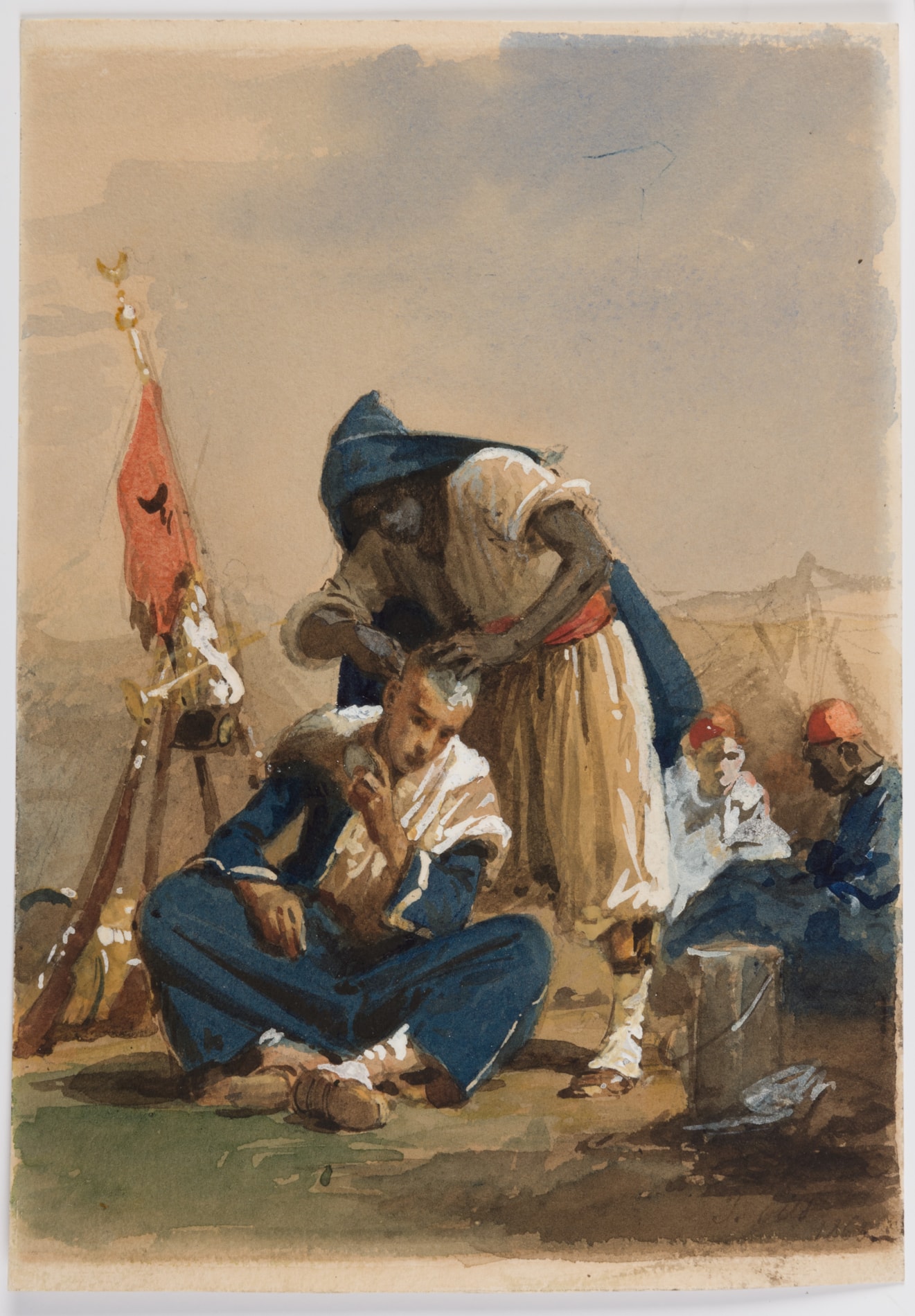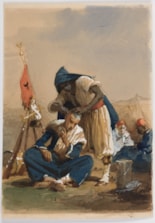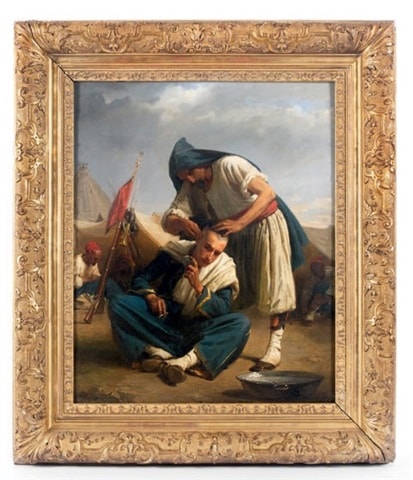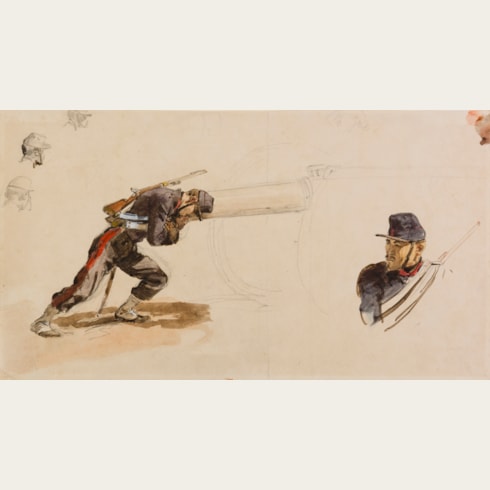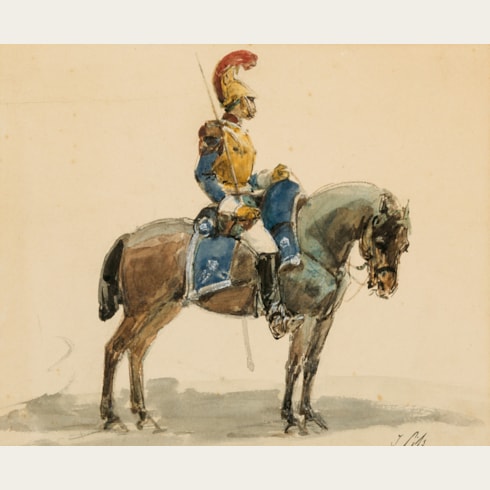Isidore PILS
(Paris 1813 - Douarnenez 1875)
The Barber
Sold
Brown wash and watercolour, heightened with white gouache, over an underdrawing in pencil.
Signed and dated I. Pils / 1863 at the lower right.
221 x 156 mm. (8 3/4 x 6 1/8 in.) [sheet]
Signed and dated I. Pils / 1863 at the lower right.
221 x 156 mm. (8 3/4 x 6 1/8 in.) [sheet]
Dated 1863, the present sheet was drawn soon after Isidore Pils' return to Paris from two years in Algeria, which had been conquered by France in 1830. Pils had gone there in order to prepare studies for a monumental painting commemorating the Emperor Napoleon III’s official visit to Algeria in 1860. (Completed in 1867, the finished painting, which measured nearly fifty feet in length, is now lost.) While in Algeria, Pils spent most of his time in Kabylia, in the northern part of the country, making sketches of the landscapes and people.
This watercolour depicts soldiers in the distinctive uniforms of one of the French army regiments of colonial troops, either Zouaves or tirailleurs. Zouave soldiers were originally recruited mainly from Algeria, and in particular from the Zouaoua mountain tribe of Kabyle Berbers, who had a reputation as fierce fighters. Tirailleurs were also recruited in the French colonial territories and were, like the Zouaves, used as light infantry. Like Zouaves, many tirailleurs were from the Maghreb countries of Algeria, Morocco and Tunisia, while others were from Senegal and other West and Central African territories.
This drawing is a preparatory study for a small oil painting by Pils of the same composition, which appeared at auction in 2001 and 2019. Both the drawing and the painting may in turn be related to an unfinished and much larger compositional oil sketch of a military encampment, incorporating two similar figures but seen from a different angle, that was offered for sale at auction in Paris in 2020.
This watercolour depicts soldiers in the distinctive uniforms of one of the French army regiments of colonial troops, either Zouaves or tirailleurs. Zouave soldiers were originally recruited mainly from Algeria, and in particular from the Zouaoua mountain tribe of Kabyle Berbers, who had a reputation as fierce fighters. Tirailleurs were also recruited in the French colonial territories and were, like the Zouaves, used as light infantry. Like Zouaves, many tirailleurs were from the Maghreb countries of Algeria, Morocco and Tunisia, while others were from Senegal and other West and Central African territories.
This drawing is a preparatory study for a small oil painting by Pils of the same composition, which appeared at auction in 2001 and 2019. Both the drawing and the painting may in turn be related to an unfinished and much larger compositional oil sketch of a military encampment, incorporating two similar figures but seen from a different angle, that was offered for sale at auction in Paris in 2020.
Born into a family of artists, Isidore-Alexandre-Augustin Pils was a student of François-Edouard Picot at the Ecole des Beaux-Arts. He won the Prix de Rome in 1838 and spent the next five years in Italy, until 1844. The early part of his career was taken up with mostly religious subjects, although he began to paint military scenes after the Crimean war, in which he acted as an observer. His success as a military painter led to further commissions, including a number of paintings for Napoleon III. One of the artist’s most important paintings, Soldiers Distributing Bread and Soup to the Poor, was commissioned by the State for the sum of 4,000 francs and was exhibited at the Salon of 1852. (The painting has since been lost, and is known only through a lithographic reproduction.) In 1857 a large canvas of a major Crimean episode, The Passage of the River Alma, was commissioned for Versailles.
Pils was also interested in scenes from modern history, exemplified by his famous painting of Rouget de Lisle Singing the 'Marseillaise', exhibited to popular acclaim at the Salon of 1849. Pils also executed a number of paintings for Parisian churches - notably the decoration of the chapel of Saint André in the church of Saint Eustache, painted between 1849 and 1852 and still in situ - and took part in the mural decoration of the Opéra. In 1864 he was appointed a Professor at the École des Beaux-Arts, and made several watercolours of life in Paris during the Prussian siege of the city in 1871.
Pils made numerous drawings, watercolours and oil sketches in preparation for each of his paintings, and particularly for individual figures within the composition. He made his first watercolours of military subjects in the early 1850s, when he began to make studies of soldiers encamped at Vincennes, near Paris.
Pils was also interested in scenes from modern history, exemplified by his famous painting of Rouget de Lisle Singing the 'Marseillaise', exhibited to popular acclaim at the Salon of 1849. Pils also executed a number of paintings for Parisian churches - notably the decoration of the chapel of Saint André in the church of Saint Eustache, painted between 1849 and 1852 and still in situ - and took part in the mural decoration of the Opéra. In 1864 he was appointed a Professor at the École des Beaux-Arts, and made several watercolours of life in Paris during the Prussian siege of the city in 1871.
Pils made numerous drawings, watercolours and oil sketches in preparation for each of his paintings, and particularly for individual figures within the composition. He made his first watercolours of military subjects in the early 1850s, when he began to make studies of soldiers encamped at Vincennes, near Paris.

